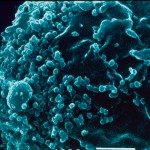Link to Pubmed [PMID] – 22045342
Link to DOI – 10.1097/QAD.0b013e32834e1484
AIDS 2012 Jan; 26(2): 139-48
Persistent immune activation plays a central role in the pathogenesis of HIV disease. Besides natural regulatory T cells (nTregs), ‘double negative’ T cells shown to exhibit regulatory properties could be involved in the control of harmful immune activation. The aim of this study was to analyze, in patients with primary HIV infection (PHI), the relationship between CD4(+)CD25(+)CD127(low)FoxP3(+) nTregs or CD3(+)CD4(-)CD8(-) double negative T cells and systemic immune activation.A prospective longitudinal study of patients with early PHI.Twenty-five patients were included. Relationships between frequency of Treg subsets and T-cell activation, assessed on fresh peripheral blood mononuclear cells, were analyzed using nonparametric tests. Cytokine production by double negative T cells was assessed following anti-CD3/anti-CD28 stimulation.No relationship was found between T-cell activation and frequencies of nTregs. In contrast, a strong negative relationship was found at baseline between the proportion of double negative T cells and the proportion of activated CD8 T cells coexpressing CD38 and HLA-DR (P = 0.005) or expressing Ki-67 (P = 0.002). In addition, the frequency of double negative T cells at baseline negatively correlated with the frequency of HLA-DR(+)CD38(+)CD8(+) T cells at month 6, defining the immune activation set point (P = 0.031). High proportions of stimulated double negative T cells were found to produce the immunosuppressive cytokines transforming growth factor-β1 and/or IL-10.The proportion of double negative T cells at baseline was found to be predictive of the immune activation set point. Our data strongly suggest that double negative T cells may control immune activation in PHI. This effect might be mediated through the production of TGF-β1/IL-10 known to downmodulate immune activation.






